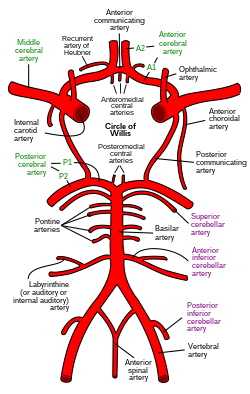Cerebral arterial circle
| Circle of Willis | |
|---|---|

Schematic representation of the circle of Willis, arteries of the brain and brain stem. Blood flows up to the brain through the vertebral arteries and through the internal carotid arteries.
|
|

The arteries of the base of the brain. Basilar artery labeled below center. The temporal pole of the cerebrum and the cerebellar hemisphere have been removed on the right side. Inferior aspect (viewed from below).
|
|
| Details | |
| Identifiers | |
| Latin | Circulus arteriosus cerebri Circulus Willisi |
| MeSH | A07.231.114.228.351 |
| TA | A12.2.07.080 |
| FMA | 50454 |
|
Anatomical terminology []
|
|
The circle of Willis (also called Willis' circle, loop of Willis, cerebral arterial circle, and Willis polygon) is a circulatory anastomosis that supplies blood to the brain and surrounding structures. It is named after Thomas Willis (1621–1675), an English physician.
The circle of Willis is a part of the cerebral circulation and is composed of the following arteries:
The middle cerebral arteries, supplying the brain, are not considered part of the circle.
The left and right internal carotid arteries arise from the left and right common carotid arteries.
The posterior communicating artery is given off as a branch of the internal carotid artery just before it divides into its terminal branches - the anterior and middle cerebral arteries. The anterior cerebral artery forms the anterolateral portion of the circle of Willis, while the middle cerebral artery does not contribute to the circle.
The right and left posterior cerebral arteries arise from the basilar artery, which is formed by the left and right vertebral arteries. The vertebral arteries arise from the subclavian arteries.
The anterior communicating artery connects the two anterior cerebral arteries and could be said to arise from either the left or right side.
All arteries involved give off cortical and central branches. The central branches supply the interior of the circle of Willis, more specifically, the Interpeduncular fossa. The cortical branches are named for the area they supply. Since they do not directly affect the circle of Willis, they are not dealt with here.
Considerable anatomic variation exists in the circle of Willis. Based on a study of 1413 brains, the classic anatomy of the circle is only seen in 34.5% of cases. In one common variation the proximal part of the posterior cerebral artery is narrow and its ipsilateral posterior communicating artery is large, so the internal carotid artery supplies the posterior cerebrum. In another variation the anterior communicating artery is a large vessel, such that a single internal carotid supplies both anterior cerebral arteries.
...
Wikipedia
